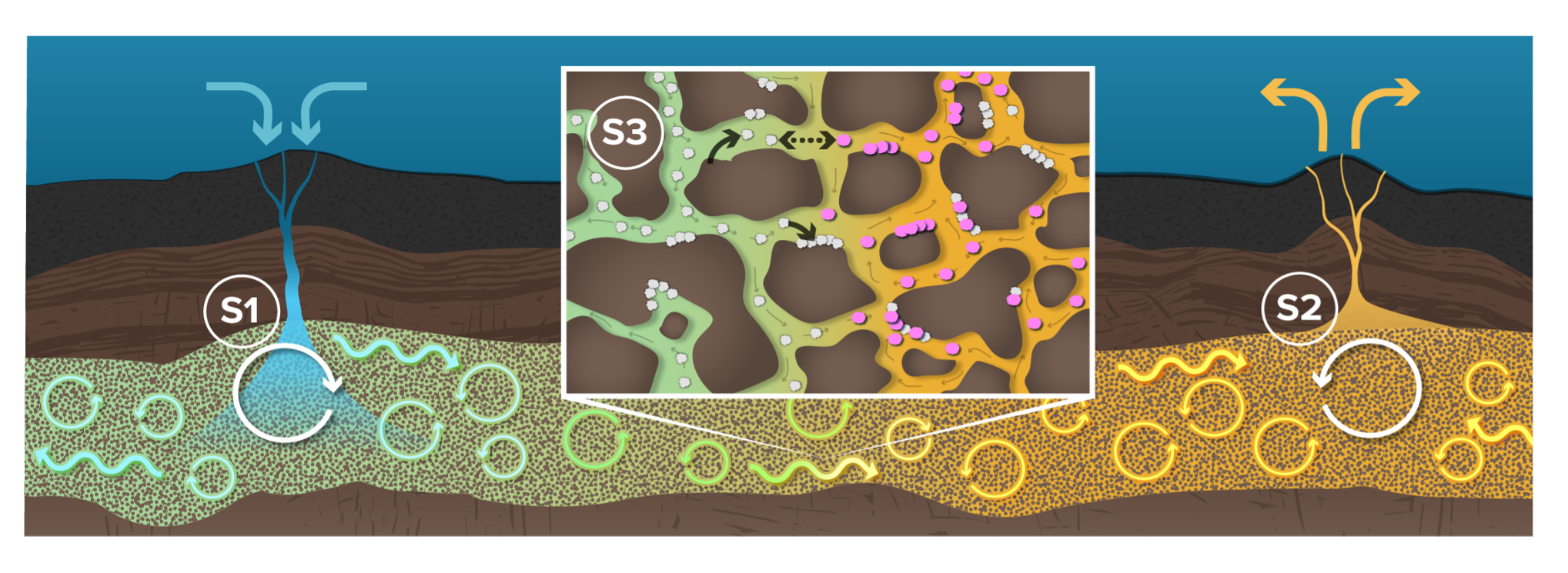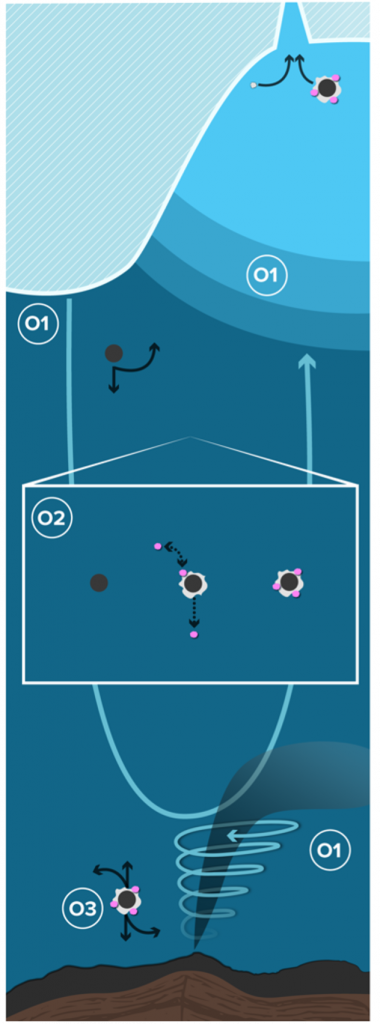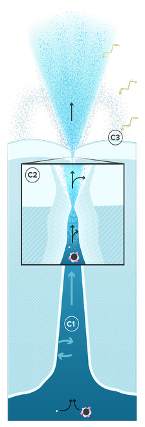Investigating Ocean Worlds (InvOW)
A Systems Level Approach to Understanding Organic Carbon Cycles.
The 2023-2032 Planetary Science and Astrobiology Decadal Survey (PSADS) prioritized missions to seek evidence for life at ocean worlds in the outer solar system. The concept studies for those missions feature organic analysis as a primary means of detecting life. To optimize the science yield of such missions, however, it is critical to understand the processes that govern maturation of organic matter from both abiotic and (potential) biological sources. In this project, therefore, we will integrate physical, chemical and biological approaches to address the question:
How do the physical, chemical and (potential) biological processes active on ocean worlds shape the nature of the organic "signal", including evidence for life, that is presented to an observing spacecraft?
Principal Investigator
Chris German
Woods Hole Oceanographic Institution
Deputy Principal Investigator
Tori Hoehler
NASA Ames Research Center
Project Manager
Kathryn Pietro
Woods Hole Oceanographic Institution

On Earth, abundant solar energy fuels a tremendous influx of biologically derived organic carbon to the ocean, yet compounds typically sought as evidence of life comprise only a tiny fraction of the dissolved organic carbon (DOC) pool. On ocean worlds, this 'needle-and-haystack' paradigm may be accentuated: the organic content of the chondritic and cometary materials from which ocean worlds are built constitutes a potentially vast reservoir of abiotic carbon, the nature of which could be challenging but also immensely informative for life detection efforts. In parallel, any ocean word biological productivity would almost certainly be diminished by orders of magnitude relative to Earth, leading to lower concentrations of target compounds and/or longer residence times - increasing the role that abiotic degradation could play in obscuring evidence of biogenicity.
Our study will investigate organic maturation across three domains that constitute a single ocean world hydrosphere:
- the subseafloor domain, where fluid circulation through silicates can both liberate chondritic organics and modify/react oceanic DOC.
- the ocean domain, where suspended particulates could serve to concentrate organics and catalyze their reactions.
- the cryosphere domain, where partitioning of organics across phase boundaries and post-depositional modification could alter and fractionate the organic "signal" presented to observing spacecraft.
Each of these domains are interconnected by flows of heat, fluid, and chemicals, and so the study will implement a "systems-level" approach consistent with the team's strong grounding in Earth-based oceanography and polar research together with planetary science and astrobiology.
Within each investigation, we will pursue an interdisciplinary approach that encompasses modeling the physics of heat, fluid, and mass transport; exploring the corresponding implications for chemical reactivity and fluxes via both modeling and experimentation; and evaluating the implications for biology as both a sink and a source term for organic carbon cycling - again via a combination of modeling and experimentation.
Investigation 1: Subseafloor Domain

Fluid-rock reactions resulting from circulation of heated water through the subseafloor of an ocean world have potential to be a primary control on organic and elemental cycling and distributions. We will investigate subseafloor processes through the pursuit of three interconnected objectives.
Objective S1: Apply state-of-the-art hydrogeology models to predict key conditions and processes during fluid circulation through the subseafloor of icy moons.
Objective S2: Constrain subseafloor chemical efflux and biological potential
Objective S3: Determine the survivability, reactivity, and tracer potential of organic matter during circulation through an ocean-world subseafloor.
Using hydrogeologic models, we will evaluate the nature of subseafloor fluid flow as constrained by physical parameter sets that vary across plausible ranges for Europa and Enceladus (S1), to determine corresponding ranges in properties such as fluid temperature, residence time, and efflux rates that would govern chemical reaction and flux. We will use geochemical reaction models to infer how those factors influence the rates and nature of fluid-rock reactions, predict how fluid composition and chemical fluxes vary in response, and model the biological productivity that could be supported within the subseafloor and during the release of hydrothermal fluids into the overlying oceans (S2). We will conduct sophisticated and controlled laboratory experiments to resolve the mechanisms of organic reactions, using conditions appropriate for Europa and Enceladus, and explore the fidelity of specific compounds as tracers of physicochemical conditions in the subseafloor (S3) and in the overlying ocean (Investigation 2). This investigation will be led by Andy Fisher (UCSC), an expert in subseafloor hydrogeology, and Susan Lang (WHOI), an expert in oceanic/hydrothermal organic geochemistry.
Investigation 2: Ocean Domain
Ocean circulation governs heat, fluid and chemical mass transport – both within an ocean and to and from the subseafloor and ice shell. These processes establish chemical gradients and disequilibria through mixing and stratification, and can suspend, transport and redistribute particulate material that can concentrate and catalyze reactions of organic matter. Through pursuit of three specific objectives, this investigation will evaluate OM reactivity and the survivability and transmission of organic signatures from rock-water processes in the Subseafloor (Inv.1) to the base of the Cryosphere (Inv.3).
Objective O1: Model ocean circulation and particle behavior for Enceladus and Europa
Objective O2: Determine the rates and nature of low-temperature organic matter reactions in the ocean water column
Objective O3: Integrate ocean OM transport and reaction in a 2D ART model
Using sophisticated, computationally efficient, numerical models, we will predict ocean circulation, particle suspension and sedimentation characteristics for a range of plausible Enceladus and Europa conditions (O1). Experimentally, we will evaluate the potential impact of particle-mediated organic reactions by determining the rates and nature of organic matter (OM) reactions with mineral and microbial catalysts (O2). We will then develop 2-dimensional Advective Reactive Tracer (ART) models that combine oceanic transport and reaction of OM within a single integrated framework (O3). The ART models will be a novel product of the Ocean Domain investigation that establishes connectivity, with respect to both physical and chemical fluxes, from Subseafloor to Cryosphere to Mission Detection. The Ocean domain investigation will be led by Barndy Toner (U.Minn), an expert in mineral-organic-microbe interactions, and Wanying Kang (MIT), an expert in geophysical fluid dynamics and physical oceanographic modeling.

Investigation 3: Cryosphere Domain

Transport through kilometers-thick ice shells and exposure to the space environment can alter the chemistry of ocean-derived fluids and particles, and therefore the insights they may provide regarding ocean properties and processes. This investigation will evaluate organic chemical change in liquid flowing through ice (C1), through the vacuum-induced phase transition to vapor and ice grains (C2), and once exposed to surface conditions (C3) through a combination of field work, modeling, and controlled laboratory experiments.
Objective C1: Characterize organic matter reactions in water-ice aquifers
Objective C2: Model transport and measure transformations in liquid-vacuum conduits
Objective C3: Characterize the potential for OM reactions at the exterior of ocean worlds
This work will build on and extend the state of the art by integrating these approaches to develop a predictive organic fractionation model that treats mass transport and chemical change in an integral framework, spanning a continuum from ocean to space.
The Cryosphere investigation will be led by Melisa Diaz (Ohio State University), an expert in polar environmental biogeochemistry, and Marc Neveu (UMD / NASA-GSFC), an expert in ocean world processes.
